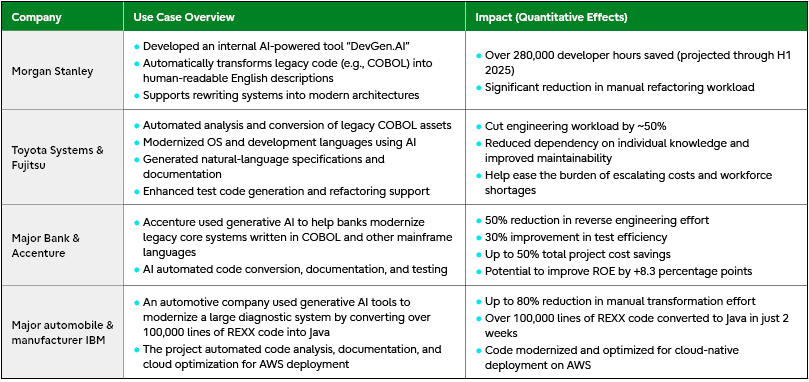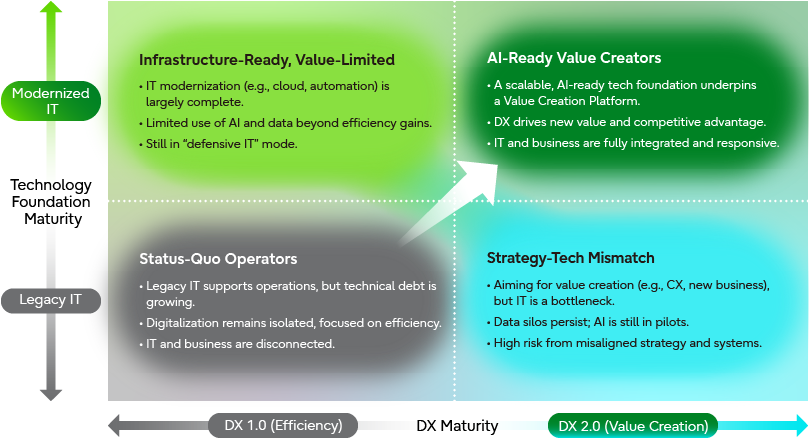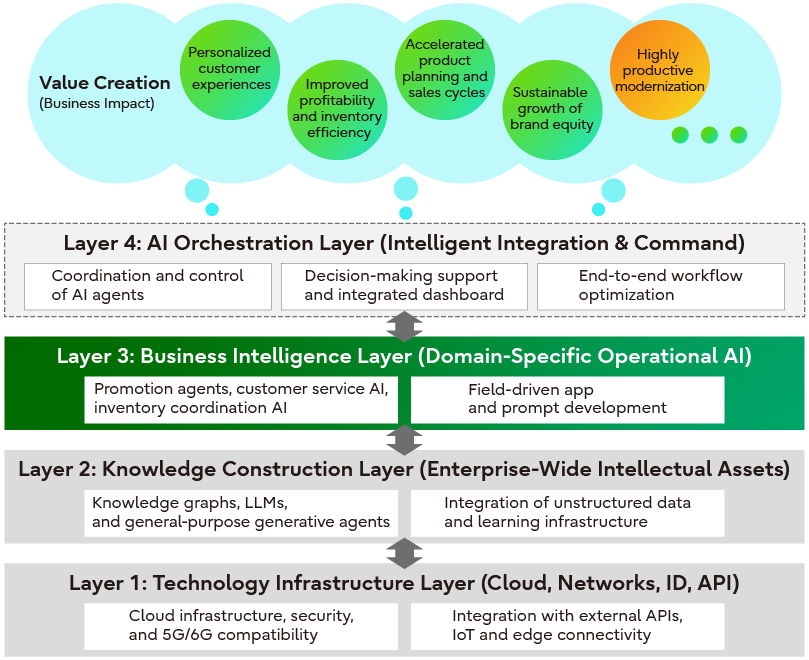―From Modernization to Value Creation- Transforming the Digital Core in the Age of Generative AI

Insight | 2025-10-10
10 minute read
The rise of Generative AI marks a new era of corporate transformation (DX 2.0), demanding a shift from mere efficiency to strategic value creation. However, many enterprises are constrained by technical debt and legacy IT systems, limiting their ability to innovate. This paper argues that traditional IT modernization is no longer sufficient. It proposes a strategic path for organizations to evolve into "AI-Native Enterprises" by fundamentally rebuilding their digital core. The centerpiece of this vision is the "AI-Native Integrated Platform," a four-layer architecture designed for holistic value creation: 1) Technology Foundation, 2) Knowledge Construction, 3) Business Intelligence, and 4) AI Orchestration. This framework enables companies to strategically resolve technical debt, align IT with business goals, and build a sustainable competitive advantage in the AI era.
1. Evolution of Digital Technologies and Corporate Transformation: Pathway to the Generative AI Era
Over the past two decades, rapid advances in digital technologies have fundamentally transformed the very nature of business. Starting from on-premises systems centered on core infrastructure and intranets, the technological foundation has expanded to include mobile, cloud, blockchain, big data, and AI. Since 2023, the emergence of generative AI and agentic AI has accelerated this transformation, pushing companies to evolve at unprecedented speed and scale.
Corporate transformation has similarly matured, progressing from initial efforts focused on operational efficiency to comprehensive enterprise-wide digital transformation, which entails redesigning organizational structures, decision-making processes, and even business models.
At the heart of this evolution lies IT modernization, whose importance continues to grow. More than a simple technology upgrade, IT modernization demands rebuilding digital foundations to be flexible, agile, and scalable, while driving changes across business processes, workforce capabilities, and corporate culture. Crucially, this modernization must advance toward a value-creation platform befitting the generative AI era.
Furthermore, in response to pressing challenges such as accelerating development cycles and talent shortages, leveraging generative and agentic AI has become a strategic pillar of IT modernization. By applying AI to system development and process automation, organizations can achieve high-quality transformation despite constrained resources.
The timeline below (Table 1) summarizes this progression of technological innovation and corporate transformation. Building on this momentum, this paper explores the reconstruction of enterprise foundations and the creation of new value in the generative AI era. It aims to serve as a guide for forward-looking strategic planning in today’s rapidly evolving landscape.

2. Technical Debt and IT Modernization: Avoiding the Productivity Trap and Laying the Foundation for Value Creation
Digital technologies now permeate every aspect of business, making digital transformation (DX) a central pillar of corporate strategy. Enterprise technology is estimated to account for up to 71% of the value derived from business transformation(1). In particular, the emergence of generative AI has fundamentally altered the speed and depth of transformation now expected from enterprises. However, many organizations still rely on outdated IT environments, which act as a brake on transformation. To drive meaningful change, companies must start by fundamentally rethinking and modernizing their digital foundations—what we call IT modernization.
Technical debt(2), often embodied in legacy systems, leads to rising maintenance costs, sluggish innovation, slow response to change, and poor integration with emerging technologies like generative AI. These factors create "invisible costs" that undermine the returns on transformation investments—turning what was once an IT issue into a core challenge for business competitiveness.
Traditional IT modernization efforts have largely focused on technical migration—updating code and infrastructure. But this alone is no longer sufficient to unlock agility and innovation. What is now required is a holistic reinvention, encompassing not just technology, but also development methods, architectures, processes, organizational structures, and talent. Deploying generative AI without being AI-ready can backfire, resulting in lower productivity(3).
In this context, the use of generative AI in IT modernization itself is gaining attention. Leading global enterprises—such as Morgan Stanley(4), Toyota Systems & Fujitsu(5), a major bank & Accenture(6), and a major automotive manufacturer & IBM(7)—are leveraging generative AI for code conversion, automated documentation, and test support. These efforts have led to significant reductions in manual work and accelerated transformation timelines (see Table 2).

The use of generative AI is also expanding beyond finance and manufacturing into the public sector, including local governments(8). Furthermore, the emergence of multi-agent autonomous systems, or agentic AI, is beginning to redefine what’s possible. These intelligent agents are expected to serve as powerful enablers of faster, cheaper, and more effective modernization. Proof-of-concept trials have shown that generative AI alone can reduce modernization timelines by around 20%, while agentic AI can cut them by up to 50%, dramatically boosting speed and productivity(9).
That said, IT modernization must not become an end in itself, narrowly focused on code translation or technical productivity. The true objective is to build a foundation—one that supports sustained enterprise transformation and unlocks long-term value creation in the AI-driven era.
3. Rebuilding the Enterprise Foundation for the Generative AI Era: Beyond IT Modernization Toward Strategic Value Creation
As generative AI enters full-scale adoption, enterprise digital transformation is shifting into a new phase. Traditional DX initiatives (DX 1.0) have primarily focused on digitalizing and automating business processes to improve operational efficiency.
Technologies such as RPA, cloud computing, and data analytics — along with rule-based or machine learning-driven AI — have played central roles in these efforts.
In contrast, DX 2.0, driven by generative and agentic AI, demands more fundamental transformation. It requires organizations to re-examine their business models, organizational structures, and even their core purpose and sources of competitive advantage.
To clarify this shift, Table 3 outlines the key differences between DX 1.0 and DX 2.0 across multiple dimensions. Notably, the transition is not only technological, but also organizational and strategic. In DX 2.0, AI plays a central role in decision-making and creative processes, working alongside people — or in some cases, autonomously — to drive company-wide transformation. The impact reaches beyond operations, influencing corporate values and the very nature of how businesses compete and create value.

In light of this shift, the role of IT modernization must also be redefined. It is no longer sufficient to simply replace legacy systems or upgrade infrastructure. Organizations must now build a next-generation foundation — one that is agile, scalable, data-driven, and capable of supporting continuous innovation and strategic value creation in the AI era.
To help organizations assess their current position and future direction, The author proposes a two-axis matrix (Figure 1) that maps technology maturity (Legacy IT to Modernized IT) against DX maturity (from DX 1.0 to DX 2.0). Today, many companies still find themselves in the lower-left or upper-left quadrants. To compete in the generative AI era, they must aim for the top-right — where modernized infrastructure and strategic, AI-driven transformation are fully aligned.

Generative AI is not just another emerging technology — it is a force that challenges the foundation of enterprise strategy. For this reason, organizations must shift from a defensive approach to IT, to a proactive, value-centric rethinking of their enterprise foundations. This is the only way to sustain relevance, agility, and growth in the era ahead
4. Laying the Foundation for Value Creation: Principles and Blueprint of AI-Native Platforms
Fujitsu acknowledges that traditional, isolated system integration methods are inadequate for tackling the growing complexity of management challenges, which have become increasingly difficult to address using conventional, siloed approaches. In response, Fujitsu emphasizes the importance of enabling organizations to continuously evolve their business and operations by actively leveraging data and AI. To support this transformation, Fujitsu proposes the Enterprise Agentic Foundation—an autonomous enterprise platform designed to maximize the value of data and AI through agent-driven business transformation, IT modernization, and integrated security across all operations(10).
Building on this proposition, the author contends that in any industry where IT modernization is imperative, evolving toward an AI-native enterprise—one that places AI not merely as a tool, but as a core driver of value creation—requires a redefinition of the integrated platforms that support cross-functional and knowledge-intensive activities. To that end, the author proposes a four-layer architectural framework that moves beyond the traditional IT-centric IaaS/PaaS/SaaS model, integrating technology, knowledge, operations, and orchestration in an organic and cohesive manner.
AI-Native Integrated Platform: Four-Layer Architecture
This platform is composed of four interrelated layers, each designed to work organically to support scalability, knowledge integration, business optimization, and decision-making across the enterprise (see Figure 2).

1) Technology Foundation Layer
This layer provides a scalable and reliable enterprise-wide IT infrastructure, including cloud, networking, security, identity management, and edge processing. It serves as the operational backbone that enables flexible deployment and reuse across upper layers.
2) Knowledge Construction Layer
This layer integrates and structures internal documents and domain-specific knowledge, leveraging large language models (LLMs) and knowledge graphs to support continuous learning and knowledge sharing. It also houses general-purpose generative agents such as legal support AI and prompt-generation assistants.
3) Business Intelligence Layer
Focused on business domains such as product planning, customer engagement, marketing, and inventory management, this layer hosts specialized AI scenarios and agent clusters. It enables domain-specific KPI ownership while maintaining flexibility to accommodate frontline innovation and operational context.
4) AI Orchestration Layer
Acting as the command center for enterprise-wide optimization, this layer manages inter-agent collaboration, data flow control, user experience integration, and decision support. As agentic AI continues to evolve, this layer will play an increasingly critical role as the enterprise's “intelligent chain of command.”
Platform Operating Model: Balancing Standardization and Flexibility
The proposed four-layer structure is not merely a technical separation of functions—it also serves as an effective framework for clarifying governance and operational accountability across the organization.
•Layers 1 and 2 (Technology Foundation & Knowledge Construction)
These layers are designed for centralized investment and operations across the enterprise, with an emphasis on cost efficiency, consistent quality, and robust security.
•Layer 3 (Business Intelligence)
This layer enables decentralized knowledge utilization and application development by individual business units and frontline teams, ensuring agility and responsiveness to local needs.
•Layer 4 (AI Orchestration)
This layer provides enterprise-wide coordination, enabling strategic execution and optimization through cross-functional orchestration and intelligent control.
Together, this structure supports both top-down strategic alignment and bottom-up innovation—making it a key enabler for scaling AI adoption across the organization.
Furthermore, it functions as a shared foundation for productivity gains by leveraging generative and agentic AI, fully aligned with the goals of IT modernization, which form the starting point of this paper.
Implications for IT Modernization
The four-layer platform architecture proposed in this paper serves not only as a foundation for enhancing productivity through the use of generative and agentic AI in IT modernization, but also as a strategic framework for guiding system renewal and design. The following are key implications:
•Gradual Resolution of Technical Debt
By leveraging a shared foundational platform, organizations can progressively rationalize and consolidate fragmented legacy IT systems, enabling a realistic and phased transition away from outdated environments.
•Enterprise-Wide Optimization of Investment and Operations
Standardizing infrastructure and knowledge platforms across the organization helps eliminate redundant investments, while enhancing operational efficiency and consistency in quality.
•Strategic Prioritization of Modernization Targets
Rather than pursuing a full-scale overhaul, companies can strategically concentrate resources on areas directly linked to value creation, guided by a forward-looking vision of AI utilization.
•Alignment Between IT Renewal and Business Transformation
Positioning IT modernization as a foundation for business intelligence and enterprise orchestration enables technology updates to translate more directly into tangible business outcomes.
By adopting these perspectives, IT modernization evolves beyond infrastructure renewal and becomes a driver of strategic transformation closely aligned with enterprise value creation.
5. Beyond Modernization — Charting the AI-Native Path Together
The rise of generative AI is fundamentally reshaping how organizations create value. Throughout this paper, we have explored how IT modernization can serve as the foundation for a broader transformation— toward a future shaped by the aspiration to become an AI-native enterprise, built on a unified platform for value creation.
Addressing technical debt and establishing a shared infrastructure for knowledge and data utilization is no longer the sole responsibility of IT departments. It represents a strategic shift: the construction of a new foundation for enterprise-wide value creation, enabling organizations to adapt to change and grow sustainably with society.
The journey will differ for every organization. However, when leaders articulate a clear vision and engage teams through open dialogue, they foster the conditions for an organization to learn, evolve, and act with autonomy.
Now is the time to look beyond modernization—not just to upgrade systems, but to reimagine what’s possible. The path to becoming AI-native will be uniquely your own, and it begins not with technology alone but with the choices made by your people and your leadership.
References
(1) Aamer Baig, et al. (April 2023)“Breaking technical debt’s vicious cycle to modernize your business”
(2) Technical debt refers to a state where prioritizing current development speed results in additional work or costs arising in the future.
(3) Joel Becker, et al. (July 2025) “Measuring the Impact of Early-2025 AI on Experienced Open-Source Developer Productivity”
(4) Alice Tecotzky (Jul 1, 2025) “A team of engineers saved Morgan Stanley more than 280,000 hours this year. The bank says its tool won't take jobs.”
(5)Fujitsu press release (October 24, 2024) ”Fujitsu and Toyota Systems Corporation achieve 50% reduction in core system update time using generative AI”
(6) Alvaro Ruiz, et al. (April 29, 2024) “Core banking modernization: Unlocking legacy code with generative AI”
(7) Faisal Nazir, et al. (March 4, 2025) “IBM and AWS: Accelerating code modernization with generative AI for automotive”. REXX (Restructured Extended Executor) code refers to program code written in a concise and flexible programming language developed by IBM, widely used on IBM mainframes.
(8) JULIAN KING, et al. (June 09, 2025) “HOW GENAI IS REWRITING THE RULES OF LEGACY TECH MODERNIZATION”
(9) Aaron Bawcom, et al. (December 2024) “AI for IT modernization: Faster, cheaper, better”
(10) Fujitsu Press release (June 26, 2025) “Fujitsu's Uvance Wayfinders consulting empowers customers to evolve business foundations leveraging data and AI”.
Additionally, Fujitsu AI Research Laboratory (Dr. Hiromichi Kobashi, Senior Project Director) is proposing the concept of an “Enterprise AI Agent Platform” that enables AI agents from different companies to collaborate. This initiative, envisioning a future where multi-AI agents cooperate across corporate boundaries, is framed from the perspective of “moving from orchestration to collaboration.”
Dr. Jianmin Jin (Ph.D in International Economic Law)
Chief Digital Economist Fujitsu Ltd.
Senior Director
Global Marketing Unit
2020 Fujitsu Ltd., Chief Digital Economist. 1998 Fujitsu Research Institute, Senior Fellow.
Dr. Jin's research mainly focuses on global economic, digital innovation/digital transformation, and Dr. Jin has published books such as ”Towards the Creation of a Japan’s Silicon Valley”(2020), etc.

Related Information
Reimagining Fashion Retail with Generative AI

Financial Services DX2.0: A Future Strategy Co-Created with AI Agents

AI Agents and the Pathway to Evolving Intelligent Manufacturing

A Future Strategy Powered by AI and Net Positive Thinking

AI Agents and the Transformation of the Financial Industry

Pushing the boundaries of Generative Tech: AI agent innovates

Designing the Next Generation of Intelligent Manufacturing with Generative AI

